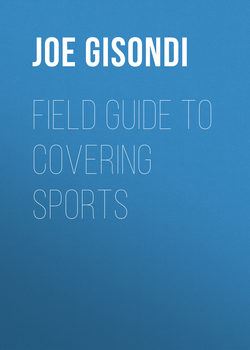Читать книгу Field Guide to Covering Sports - Joe Gisondi - Страница 9
На сайте Литреса книга снята с продажи.
Training Needed
ОглавлениеAlthough Americans play dozens of sports, just a few—football, baseball, basketball—get most of the media coverage. Millions of people follow those sports, but that doesn’t mean either fans or sportswriters understand them expertly. Teachers and editors know that their students and new hires know far less than they claim. Even so, few sports journalists receive formal training. So many young reporters cover games more like fans than professionals. They fumble through statistics, struggle to take proper notes, mishandle interviews, and settle for both clichéd language and the same old leads. They’re not sure how to identify or write about the most significant plays, trends, or moments in a game.
This book provides even the most basic writers with the tools they need to succeed on their first assignments. It trains writers to answer, in advance, the questions their editors and readers will ask: What happened? How? Why? The running back ran for 200 yards. Any fan can see that, but a journalist needs to explain why. Did the offensive tackles drive back a smaller defensive line? Did the offensive coordinator scheme so well that the defense was confused? Did this running back follow his blockers well or display amazing athleticism?
A track runner broke the county record in the mile. How? Did she take the lead early, have to kick it in for the final lap, or get pulled along by a competitive field? And how did she train to prepare for this meet?
Just like athletes, journalists need training. The introductory chapters of this book start that training by providing the big picture, with tips on interviewing sources, writing game stories, acting professionally. Chapters on blogging and covering high school sports prepare writers for two areas that are booming as news organizations focus even more on local action and interactive approaches to news.
The core of the book, the middle section, takes beginning journalists step-by-step through every one of the 20 sports they’re likely to be sent out to cover. Within each sport, four sections provide tips on how to prepare for the game, what to look for while you’re watching, whom to interview, what to ask and finally, how to write up what you’ve seen. PREPARE—WATCH—ASK—WRITE: You’ll see those four sections in each sports chapter. In addition, experienced sports journalists chime in with their own advice, sharing what they’ve learned about how to observe events, take notes and keep score, and interview players and coaches.
Of course, no book of field-guide size could possibly fit in every rule and every term for every sport a journalist might need to cover. Instead, these pages contain the basics a young reporter is most likely to need. Reporters will learn the following:
▸ Keep score accurately and effectively. Illustrated scorecards show how to record scores and take notes on auto racing, baseball/softball, basketball, bowling, and football.
▸ Understand the rules when covering an unfamiliar sport. Can golfers flick bugs off balls before hitting them? Are stock-car drivers legally allowed to bump other cars? How much tailwind nullifies a record-breaking track performance? What’s the purpose of a drag flick in field hockey?
▸ Understand the necessary terminology. What’s a “near fall” in wrestling, and what does a coxswain do in rowing? What does 6–4–3 mean in baseball? How many pins are recorded in a frame after a spare?
▸ Ask more informed questions after games. Did the safeties stay back, trying to prevent the deep pass? Did the pitcher have more spin on the ball?
